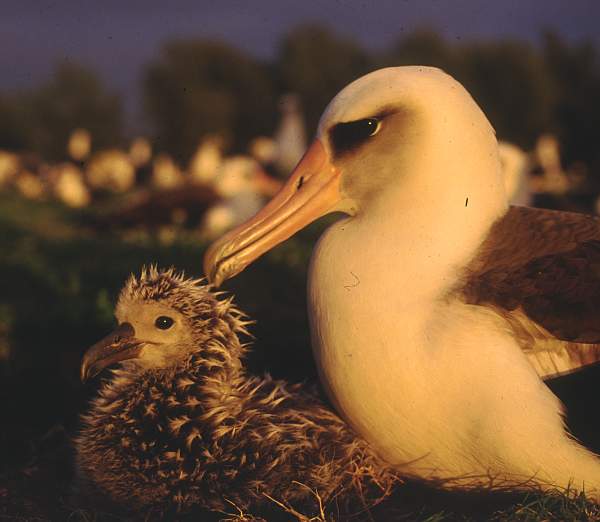Published in the Ocean Watch column, Honolulu Star-Advertiser © Susan Scott
January 11, 2010
Here at Midway, it took a team of 15 volunteers three weeks to count a half million albatross nests. Day after day, rain and shine, we marched across fields packed with albatrosses, pushed through woods teeming with albatrosses and trudged along beaches loaded with albatrosses.

Finally, the counting was done and we had a few days to relax. And what did everyone want to do? Walk around the island and watch albatrosses.
We aren’t bird fanatics — we like all wildlife. It’s just that albatrosses are so charming. For nature enthusiasts, to spend time in a Hawaii albatross colony is to fall in love for life.
Midway hosts the largest albatross colony in the world. About 75 percent of the world’s Laysan albatrosses, and 35 percent of the less numerous black-footed albatrosses, nest on this atoll’s three tiny islands.
That’s well over a million goose-sized birds, an amazing number for 2.3 square miles. Equally amazing is that the Navy occupied the atoll from the 1940s to the 1990s, building a village and airport over most of the birds’ nesting spots.
But albatrosses have a strong instinct to nest where they hatched, and year after year they returned. One female Laysan here, named Wisdom for all the changes she’s lived through, is 59 years old and currently sitting on another egg.

One instinct albatrosses don’t have is fear. These seabirds evolved without predators, and aren’t afraid of people. They are, however, curious about us.
Last week I lay in the grass to record on video a couple of courting Laysans dancing on their tiptoes and singing to high heaven.
The single birds here, called walkers, carry out these whistling, honking, clacking dances, sometimes in groups of three or four.

As I concentrated on filming this exuberant pair, I felt taps on both my shoulders. At my right stood a black-footed albatross checking out my red shirt, and on my left, a Laysan did the same.
This plucking behavior is common among albatrosses because they “feel” items with their beaks. I’ve had an albatross untie my shoelaces as I stood taking pictures, and when I squatted low for a shot, another bird pulled a tissue from my gaping pants pocket.
Sometimes I offer a curious bird my camera strap, hat or bare fingers to examine. The birds’ beaks are sharp but their exploratory touches are gentle.

You have to be alert walking around an albatross colony because they fly like angels but sometimes crash like clowns. A landing albatross once hit me squarely in the rear end and then waddled away as if nothing happened.
With their big webbed feet and widespread legs, albatrosses walk as if they’re wearing swim fins. Watching this goofy gait always makes me smile.
Once mated, a bond that lasts for life, albatross couples spend hours touching beaks, laying heads against each other’s cheeks and neck and tenderly preening one another’s velvety feathers. The two take turns sitting on their egg, and while doing so often stand, touch the egg with the beak and murmur albatross baby talk to their unborn chick.
And the chicks … well, baby birds don’t get cuter.

For information about going to this wildlife wonderland, see www.fws.gov/midway.
Friday marked the end of my visit to Midway this year. I spent the entire day, of course, watching albatrosses.